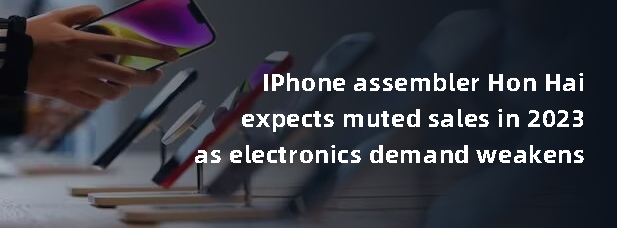Semiconductor Weekly News(5.20-5.26)| Nvidia revenue outlook confirms AI bonanza...
2023-05-29
1/ Nvidia revenue outlook confirms AI bonanza
Nvidia on last Wednesday (24) announced better-than-expected earnings last quarter and a super-optimistic revenue outlook for the current quarter due to strong demand for artificial intelligence (AI) chips.
Nvidia estimates that revenue for the quarter will reach approximately $11 billion, more than fifty percent higher than analysts expected. Such an optimistic sales outlook proves that Nvidia is benefiting from the AI boom to a far greater extent than the market imagined.
As enterprises apply generative AI to products, services and business processes, the world's multi-trillion dollar data center infrastructure will shift from general purpose to accelerated computing, fueling demand for data center products, said Jensen Huang, Nvidia's chief executive officer.
2/ Automotive, industrial IGBT supply remains tight
STAR Market Daily released on the 25th, according to industry sources, IGBT supply is still tight in industrial and automotive fields, and mainstream IDM factories are optimistic about its long-term demand all the way; only this wave of shortage has not attracted too many 6 and 8-inch fabs to put into IGBT expansion ranks.
Sources said that most of the fabs have been fully depreciated, 6-inch, 8-inch wafer fabs IGBT products in the production of cost-effective. The shortage of IGBTs is currently expected to last until 2024, the sources added, adding that they are still seeking investment due to cost competitiveness. Although few 6-inch, 8-inch fabs are expanding IGBT capacity, but some 12-inch fabs have started producing IGBTs.
Sources also added that the hot market for compound semiconductors such as gallium nitride and silicon carbide has changed the route of the fabs, with 6-inch and 8-inch fabs effectively transforming their compound semiconductor business. For example, Foxconn's current electric vehicle business is divided into three main layout: automotive "Android", third-generation semiconductors and foundry. Taiwan's Mao Silicon also plans to shift to compound semiconductor production.
3/ The global DRAM chip industry has been in recession for 3 consecutive quarters
On May 25, research firm TrendForce released a DRAM market research report. The report shows that in the first quarter of 2023, the global DRAM chip industry's revenue will be about 9.66 billion US dollars, which has fallen for three consecutive quarters. In terms of shipments, only Micron has risen, and the rest have declined.
In terms of average selling price of DRAM, Samsung, Micron, and SK Hynix all dropped. TrendForce said that the current oversupply situation in the market has not improved, and prices continue to fall. In the context of successive reductions in production by original manufacturers, the decline in DRAM prices is expected to narrow in the second half of the year. Looking forward to the second quarter, although shipments will increase, due to falling prices, the expected revenue growth will be limited.
4/ The agency predicts that Micro LED screen shipments will increase significantly, reaching 17.47 million pieces in 2027
According to foreign media Patently Apple news, display industry research institute DSCC released a forecast on May 24, indicating that the future shipments of microLED screens will grow exponentially, from the current 450,000 pieces/year to over 10 million pieces.
The agency expects microLED screen shipments to be about 450,000 in 2023, 1.81 million in 2024, 7.98 million in 2025, 13.54 million in 2026 and 17.47 million in 2027.
The agency predicts that by 2025, Apple is expected to apply MicroLED display to Apple Watch smartwatch for the first time. 2023 earlier, some foreign media sources said that Apple may be applied as early as 2024, but some observers believe that 2024 is still too early.
5/ Apple announces 2022 supply chain list
Recently, Apple announced its 2022 supply chain list, with five new entries from mainland China and eight exclusions, down three to 49, but still the largest number.
Newly entered into Apple's supply chain are Hunan Taijia New Material, Guotai Daming, Sunyu Optical, Zhuhai Guangyu and Shenzhen Forceblack Technology, while those removed are CTM Holdings Limited, Consumer HK Holds II Limited, Fulcher High-Tech, Kaisheng Technology, Shenzhen Fuchengda Technology, Deep Blue Materials, Shenzhen Fuchengda Technology, Shenzhen Fuchengda Technology and Shenzhen Fuchengda Technology, Shenzhen Fuchengda Technology, Deep Blue Materials, Zhenghe Group and Tianma Microelectronics.
In the part of Chinese and Taiwanese manufacturers, five of them joined the supply chain, but five of them were also kicked out of the list. South Korean manufacturers this time no change; Japanese companies added four, three were removed; U.S. business, Sheng Xi'ao last year was removed from the list this year, but also increased the Comu, II-VI is replaced by the subsidiary Coherent.
It is understood that in the past, Apple will publish the top 200 major suppliers, since fiscal year 2020, Apple's supply chain list only contains the first 98% of raw materials, manufacturing, assembly supplier manufacturers, the latest list of statistics for the fourth quarter of 2021 to the third quarter of 2022 fiscal year.
6/ Samsung Q3 may reduce wafer production capacity by more than 10% following memory chip production cuts
According to Korean media reports, following the reduction in production of memory chips, Samsung Electronics plans to reduce wafer production in the third quarter of 2023 due to poor demand for foundry services.
According to the report, Samsung has been maintaining 100% wafer production capacity until Q2, but in the global semiconductor industry downturn, wafer foundry orders have also decreased, and had to start reducing production from Q3.
Korean media Aju News quoted industry sources as saying that Samsung plans to reduce its production of 8nm and 10nm process wafers by more than 10% from Q3 onwards at its S3 line in South Korea's Hwaseong Park. It is reported that Hwaseong S3 line is mainly used for wafer foundry, has used extreme ultraviolet (EUV) equipment for production.
If the news is true, this will be the first time in recent years that Samsung has taken the initiative to reduce the foundry capacity of its semiconductor production lines.
7/ Nvidia urgently orders H100 and A100 from TSMC
According to Taiwan's DIGITimes, sources said Nvidia is urgently ordering its H100 and A100 from TSMC, as well as the H800 and A800 specifically designed for the mainland China market.
"Nvidia's orders have boosted TSMC's capacity utilization for its 7/6nm process, and utilization of the fab's 5/4nm process is also rising rapidly to almost full production capacity." The source added.
It is understood that demand for Nvidia AI chips has been strong from major companies around the world, and despite Nvidia's ongoing efforts to meet demand, supply continues to outstrip demand in the wake of the recent AI boom.
8/ Effective July 23rd! Japan joins the camp of restricting the export of chip equipment
This week, the Japanese government announced that new regulations restricting the export of semiconductor manufacturing equipment will officially take effect on July 23. Back in March Japan has announced the implementation of export controls on 23 kinds of high-performance semiconductor manufacturing equipment.
The new rules do not specify for China, but rather restrict 160 countries, including China, but China accounts for about thirty percent of its semiconductor manufacturing equipment exports, the highest percentage.
23 kinds of export control equipment covering semiconductor cleaning, film formation, lithography, etching, testing and many other aspects. Japan's Ministry of Economy, Trade and Industry said the move was mainly to prevent semiconductors from being used for military purposes in response to the increasingly challenging international security environment.
China's Ministry of Commerce responded that this is an abuse of export control measures, a serious departure from the rules of free trade and international trade and commerce, which China firmly opposes.









